6 Skeletal System
Learning Objectives
- Examine the anatomy of the skeletal system
- Determine the main functions of the skeletal system
- Differentiate the medical terms of the skeletal system
- Discover common diseases, disorders, and procedures related to the skeletal system
- Recognize common medical specialties associated with the skeletal system
Skeletal System Word Parts
Click on prefixes, combining forms, and suffixes to reveal a list of word parts to memorize for the Skeletal System.
Introduction to the Skeletal System
The skeletal system forms the framework of the body. It is the body system composed of bones, cartilage, and ligaments. Each bone serves a particular function and varies in size, shape, and strength. Bones are weight-bearing structures in your body and can therefore change in thickness as you gain or lose weight. The skeletal system performs the following critical functions for the human body:
- supports the body
- facilitates movement
- protects internal organs
- produces blood cells
- stores and releases minerals and fat
Watch this video:
Media 6.1. The Skeletal System: Crash Course A&P #19 [Online video]. Copyright 2015 by CrashCourse.
Practice Medical Terms Related to the Skeletal System
Anatomy (Structures) of the Skeletal System
The skeletal system includes all of the bones, cartilages, and ligaments of the body that support and give shape to the body and body structures. The skeleton consists of the bones of the body. For adults, there are 206 bones in the skeleton. Younger individuals have higher numbers of bones because some bones fuse together during childhood and adolescence to form an adult bone. The primary functions of the skeleton are to provide a rigid, internal structure that can support the weight of the body against the force of gravity, and to provide a structure upon which muscles can act to produce movements of the body.
In addition to providing for support and movements of the body, the skeleton has protective and storage functions. It protects the internal organs, including the brain, spinal cord, heart, lungs, and pelvic organs. The bones of the skeleton serve as the primary storage site for important minerals such as calcium and phosphate. The bone marrow found within bones stores fat and houses the blood-cell-producing tissue of the body.
The skeleton is subdivided into two major divisions: the axial and appendicular.
The Axial Skeleton
The axial skeleton forms the vertical, central axis of the body and includes all bones of the head, neck, chest, and back (see Figure 6.1). It serves to protect the brain, spinal cord, heart, and lungs. It also serves as the attachment site for muscles that move the head, neck, and back, and for muscles that act across the shoulder and hip joints to move their corresponding limbs.
The axial skeleton of the adult consists of 80 bones, including the skull, the vertebral column, and the thoracic cage. The skull is formed by 22 bones. Also associated with the head are an additional seven bones, including the hyoid bone and the ear ossicles (three small bones found in each middle ear). The vertebral column consists of 24 bones, each called a vertebra, plus the sacrum and coccyx. The thoracic cage includes the 12 pairs of ribs and the sternum, the flattened bone of the anterior chest.
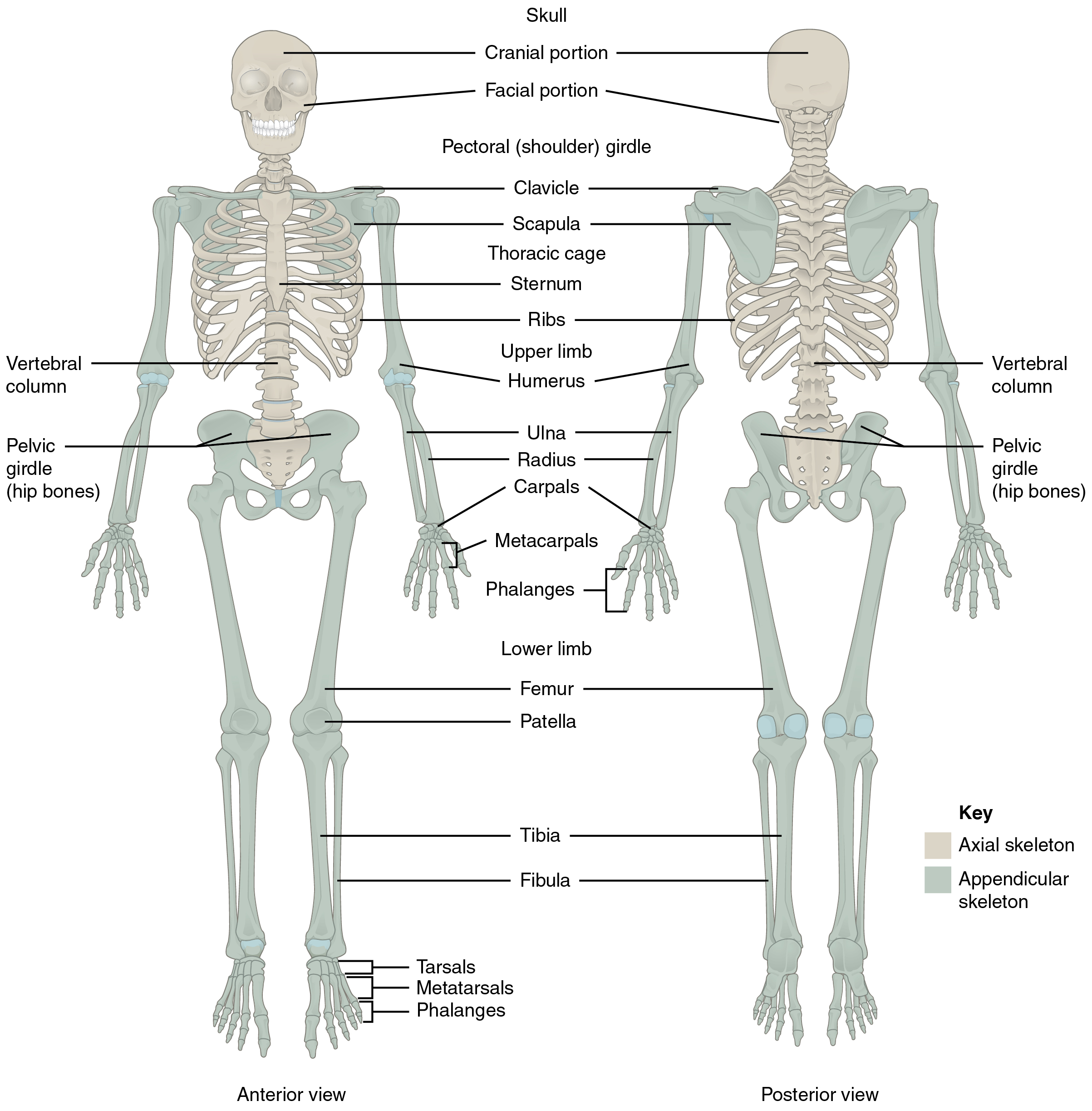
The cranium or skull supports the face and protects the brain. It is subdivided into the bones of the skull and the bones of the face.
Bones of the Skull
- Frontal – forms the forehead
- Parietal – the upper lateral sides of the cranium
- Occipital – the posterior skull and base of the cranial cavity
- Temporal – the lower lateral sides of the cranium
- Sphenoid -the ‘keystone’ bone that forms part of the base of the skull and eye sockets
- Ethmoid – forms part of the nose and orbit and base of the cranium
- Auditory ossicles – the small bones of the middle ear
- External auditory meatus – the external opening of the ear and temporal bone
Bones of the Face
- Zygomatic – the cheekbone
- Maxillary – the upper jaw and hard palate
- Palatine – the lateral walls of the nose
- Lacrimal – the walls of the orbit
- Inferior conchae – the lower lateral wall of the nasal cavity
- Vomer – the bone that separates the left and right nasal cavity
- Mandible – the lower jaw bone (the only movable bone of the skull)
- Hyoid – the bone located between the mandible and larynx, not connected to other bones
Did you know?
The axial skeleton has 80 bones and includes bones of the skull (and face), vertebral column, and thoracic cage.
Bones of the Vertebral Column
The vertebral column is also known as the spinal column or spine (see Figure 6.2). It consists of a sequence of vertebrae (singular = vertebra), each of which is separated and united by an intervertebral disc. Together, the vertebrae and intervertebral discs form the vertebral column. It is a flexible column that supports the head, neck, and body and allows for their movements. It also protects the spinal cord, which passes down the back through openings in the vertebrae.
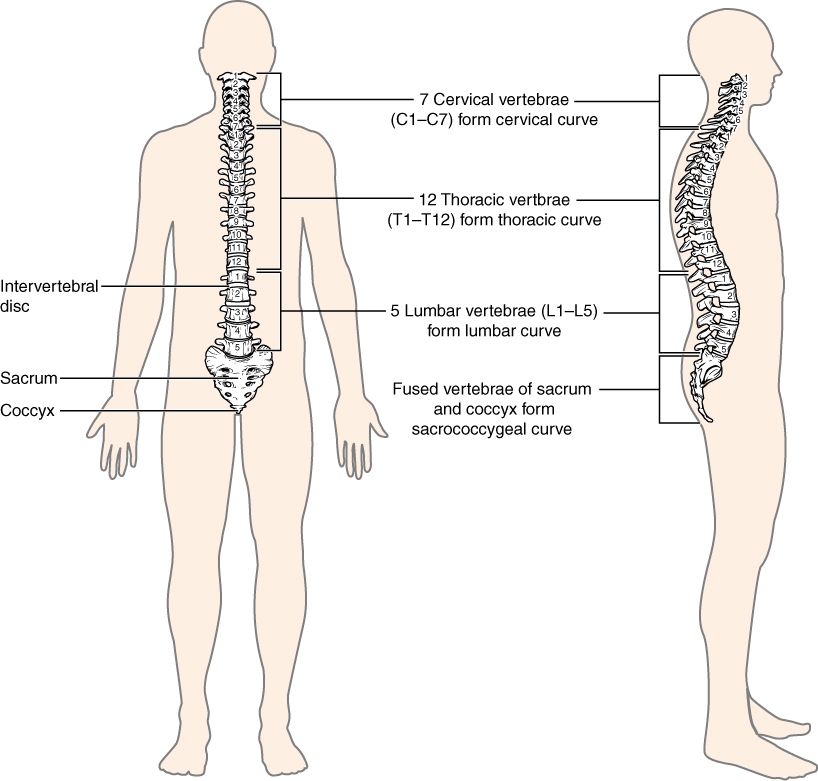
Types of Vertebrae
- Cervical – C1 to C7, the first 7 vertebrae in the neck region
- Thoracic – T1 to T12, the next 12 vertebrae that form the outward curvature of the spine
- Lumbar – L1 to L5, the next 5 vertebrae that form the inner curvature of the spine
- Sacrum – the triangular-shaped bone at the base of the spine
- Coccyx – the tailbone
Bones of the Thoracic Cavity
The thoracic cage (rib cage) forms the thorax (chest) portion of the body. It consists of the 12 pairs of ribs with their costal cartilages and the sternum (see Figure 6.3). The ribs are anchored posteriorly to the 12 thoracic vertebrae (T1–T12). The thoracic cage protects the heart and lungs.
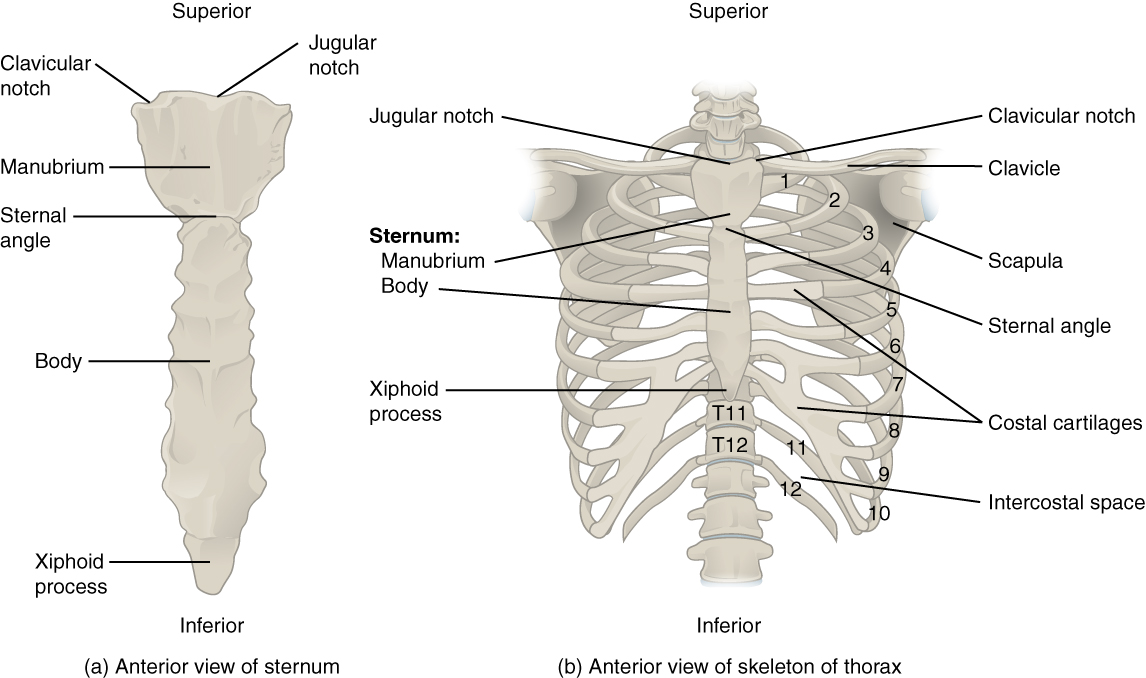
Ribs
There are 12 sets of ribs and can be divided as such:
- 7 true ribs – they are attached to the front of the sternum
- 3 false ribs – they are attached to the cartilage that joins the sternum
- 2 floating ribs – they are not attached to the front of the sternum
Sternum
The sternum, also known as the breast bone, is divided into 3 parts:
- manubrium – the upper portion of the breast bone
- body – the middle portion of the breast bone
- xiphoid process – the lower portion of the breast bone and is made up of cartilage
Concept Check
- What is the medical term for the upper jaw bone and the lower jaw bone?
- What medical term is used for the bones of the inner ear?
- How many bones make up the cervical region of the vertebral column?
The Appendicular Skeleton
Bones of the Pectoral Girdle
- Scapula – the shoulder blades
- Clavicle – the collarbone, which connects the sternum to the scapula
- Acromion – the extension that forms the bony point of the shoulder
Bones of the Upper Limbs
The bones of the upper limbs include the bones of the arms, wrists, and hands.
Bones of the Arm
- Humerus – the bone in the upper arm
- Radius – the bone that runs thumb-side of the forearm
- Ulna – the bone that runs on the side of the little finger of the forearm (Figure 6.4)
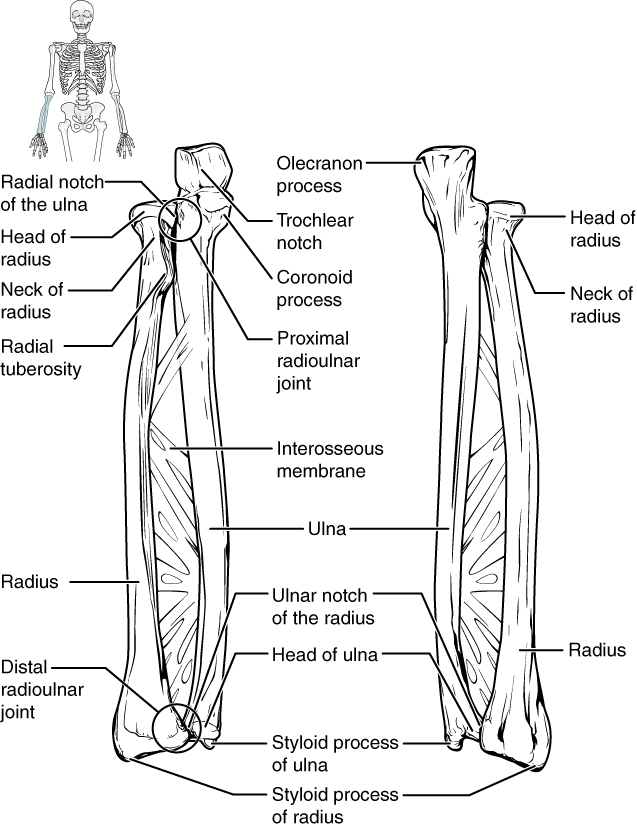
Bones of the Wrist and Hand
- Carpals – the wrist bones
- Metacarpals – the bones in the palm
- Phalanges – the finger and toe bones
Each phalanx has three bones: the distal, medial, and proximal. The exception is the thumb and big toe which has two bones: the distal and proximal (Figure 6.5). There are 30 bones in each upper limb. Can you count them on your limb?
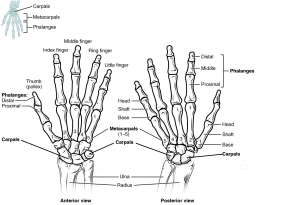
Did you know?
The appendicular skeleton has 126 bones. It is divided into the bones of the upper limbs and lower limbs that attach each limb to the skeleton.
Bones of the Pelvic Region
The bones of the pelvic region protect the reproductive, urinary, and excretory organs.
- Pelvic girdle – the hip or coxal bone; it is formed by the fusion of three bones during adolescence
- Illium – the largest part of the hip bone
- Ischium – the lower portion of pelvic girdle
- Pubis – the anterior portion of pelvic girdle
- Pelvis – consists of four bones: the left and right hip bones as well as the sacrum and coccyx
- Acetabulum – the large socket in the pelvic bones that holds the head of the femur
The shape of the pelvic girdle is different for males than females. In the male, it is a funnel shape. In the female, it is shaped like a basin to accommodate the fetus during pregnancy.
Bones of the Lower Limbs
The bones of the lower limb include bones of the leg and the feet.
Bones of the Leg
- Femur – the thigh bone and is also referred to as the upper leg bone; it is the longest and strongest bone in the human body
- Patella – the kneecap
- Tibia – the shin bone; it is a medial bone and the main weight-bearing bone of the lower leg
- Fibula – the smaller of the lower leg bones (see Figure 6.6)

Bones of the Ankles and Feet
- Tarsals – the ankle bones (7 total)
- Malleolus – the bony protrusions of the ankle bones
- Talus – the superior ankle bones
- Calcaneus – the heel bones
- Metatarsals – the foot bones
- Phalanges – the bones of the toes (see Figure 6.7)
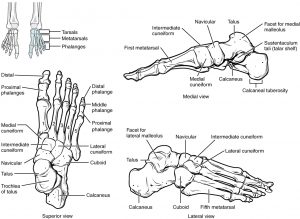
Did you know?
The femur is the longest and strongest bone of the body and accounts for approximately one-quarter of a person’s total height.
Concept Check
Answer the following questions:
- Is the humerus the same as the funny bone?
- What is the medical term for the kneecap?
Anatomy Labeling Activity
Physiology (Function) of the Skeletal System
The bones of the skeletal system are comprised of an inner spongy tissue referred to as bone marrow. There are two types of bone marrow: red and yellow. The red bone marrow produces the red blood cells, and it does so by a process called hematopoiesis. The yellow bone marrow contains adipose tissues which can be a source of energy. The bones of the skeletal system also store minerals such as calcium and phosphate. These minerals are important for the physiological processes in the body and are released into the bloodstream when levels are low in the body.
Joints
Watch this video:
Media 6.2. Joints: Crash Course A&P #20 [Online video]. Copyright 2015 by CrashCourse.
Most bones connect to at least one other bone in the body. The area where bones meet bones or where bones meet cartilage are called articulations. Joints can be classified based on their ability to move. At movable joints, the articulating surfaces of the adjacent bones can move smoothly against each other. However, other joints may be connected by connective tissue or cartilage. These joints are designed for stability and provide for little or no movement. Importantly, joint stability and movement are related to each other. This means that stable joints allow for little or no mobility between the adjacent bones. Conversely, joints that provide the most movement between bones are the least stable.
Based on the function of joints, there are 3 types of joints:
- Synarthrosis joints allow no movement.
- For example, joints of the skull
- Amphiarthrosis joints allow some movement.
- For example, joints of the pubic symphysis
- Diarthrosis joints allow for free movement.
- For example, joints of the knee
Structures associated with joints are:
- Cartilage – the elastic connective tissue that is found at the ends of bones, nose tip, et cetera
- Synovial membrane – the lining or covering of synovial joints
- Synovial fluid – the lubricating fluid found between synovial joints
- Ligaments – the tough, elastic connective tissue that connects bone to bone
- Tendons – the fibrous connective tissue that attaches muscle to bone
- Bursa – the closed, fluid-filled sacs that work as a cushion
- Meniscus – C-shaped cartilage that acts as shock absorbers between bones
Did you know?
The left and right hip bones are connected by an amphiarthrosis joint.
Body Movements
Synovial joints are movable joints and provide most of the body movements. Body movement occurs when the bones, joints, and muscles work together.
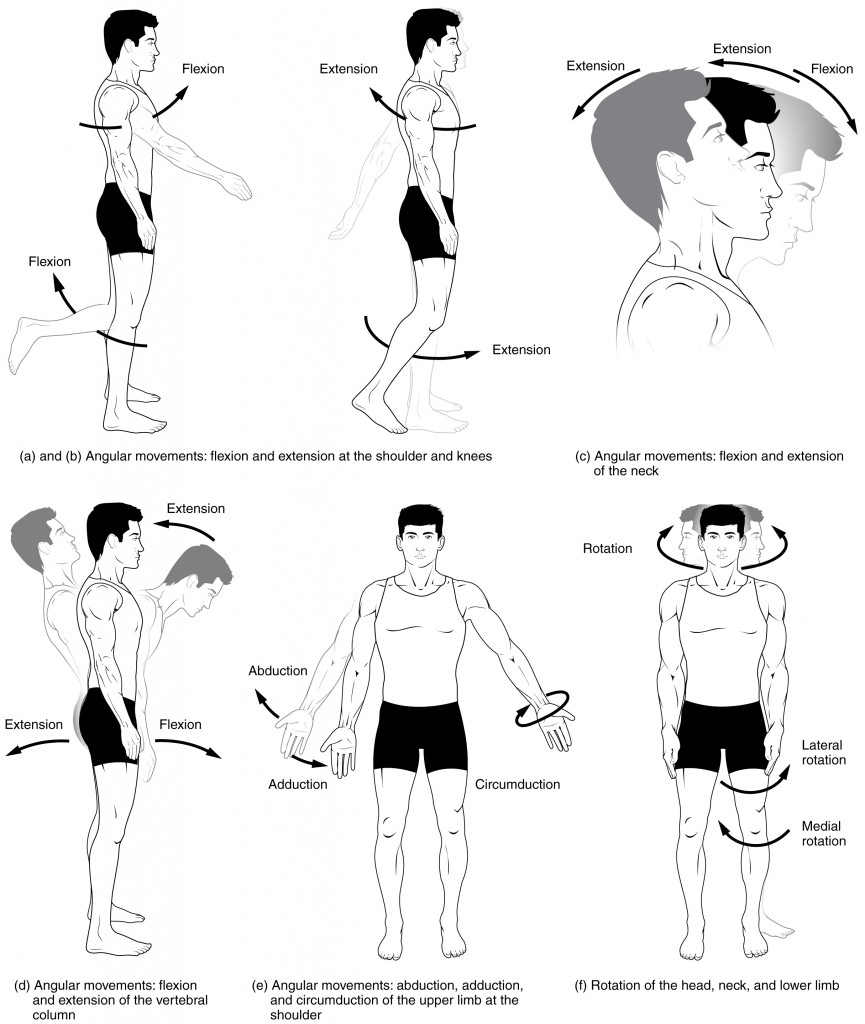
Flexion and Extension
Flexion and extension are movements that take place within the sagittal plane and involve anterior or posterior movements of the body or limbs. For the vertebral column, flexion (anterior flexion) is an anterior (forward) bending of the neck or body, while extension involves a posterior-directed motion, such as straightening from a flexed position or bending backward. Lateral flexion is the bending of the neck or body toward the right or left side. These movements of the vertebral column involve both the joints as well as the associated intervertebral disc.
In the limbs, flexion decreases the angle between the bones (bending of the joint), while extension increases the angle and straightens the joint (see Figures 6.8(a-d)). You will discover in the muscular system chapter that the associated muscles to these movements are flexor and extensor.
Abduction and Adduction
Abduction and adduction motions occur within the coronal plane and involve medial-lateral motions of the limbs, fingers, toes, or thumb. For example, abduction is raising the arm at the shoulder joint, moving it laterally away from the body, while adduction brings the arm down to the side of the body (see Figure 6.8(e)). In the muscular system chapter, you will discover that the associated muscles to these movements are the abductor and adductor.
Circumduction
Circumduction is the movement of a body region in a circular manner, in which one end of the body region being moved stays relatively stationary while the other end describes a circle. It involves the sequential combination of flexion, adduction, extension, and abduction at a joint (see Figure 6.8(e)).
Rotation
Rotation can occur within the vertebral column, at a pivot joint, or at a ball-and-socket joint. Rotation of the neck or body is the twisting movement produced by the summation of the small rotational movements available between adjacent vertebrae. At a pivot joint, one bone rotates in relation to another bone.
Rotation can also occur at the ball-and-socket joints of the shoulder and hip. Here, the humerus and femur rotate around their long axis, which moves the anterior surface of the arm or thigh either toward or away from the midline of the body (see Figure 6.8(f)).
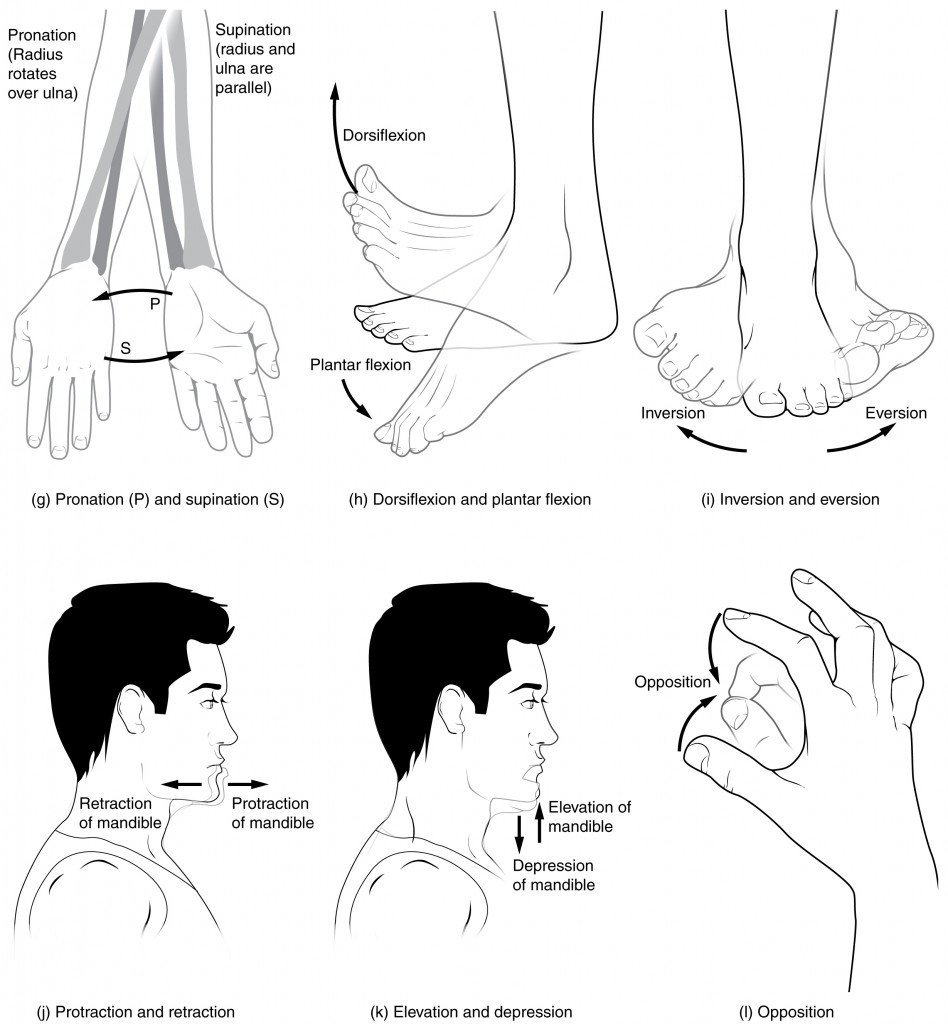
Supination and Pronation
Supination and pronation are movements of the forearm. In the anatomical position, the upper limb is held next to the body with the palm facing forward. This is the supinated position of the forearm. In this position, the radius and ulna are parallel to each other. When the palm faces backward, the forearm is in the pronated position, and the radius and ulna form an X-shape.
Pronation is the movement that allows the palm to face backward while in supination the palm faces forward. It helps to remember that supination is the motion you use when scooping up soup with a spoon (see Figure 6.9(g)).
Dorsiflexion and Plantar Flexion
Dorsiflexion and plantar flexion are movements at the ankle joint, which is a hinge joint. Lifting the front of the foot, so that the top of the foot moves (upward) toward the anterior leg is dorsiflexion, while lifting the heel of the foot from the ground or pointing the toes downward is plantar flexion. These are the only movements available at the ankle joint (see Figure 6.9(h)).
Inversion and Eversion
Inversion and eversion are complex movements that involve the multiple plane joints among the tarsal bones of the posterior foot (intertarsal joints) and thus are not motions that take place at the ankle joint. Inversion is the turning of the foot to angle the bottom of the foot toward the midline, while eversion turns the bottom of the foot away from the midline. The foot has a greater range of inversion than eversion motion. These are important motions that help to stabilize the foot when walking or running on an uneven surface and aid in the quick side-to-side changes in direction used during active sports such as basketball, racquetball, or soccer (see Figure 6.9(i)).
Protraction and Retraction
Protraction and retraction are anterior-posterior movements of the scapula or mandible. Protraction of the scapula occurs when the shoulder is moved forward, as when pushing against something or throwing a ball. Retraction is the opposite motion, with the scapula being pulled posteriorly and medially, toward the vertebral column. For the mandible, protraction occurs when the lower jaw is pushed forward, to stick out the chin, while retraction pulls the lower jaw backward (see Figure 6.9(j)).
Depression and Elevation
Depression and elevation are downward and upward movements of the scapula or mandible. The upward movement of the scapula and shoulder is elevation, while a downward movement is depression. These movements are used to shrug your shoulders. Similarly, elevation of the mandible is the upward movement of the lower jaw used to close the mouth or bite on something, and depression is the downward movement that produces the opening of the mouth (see Figure 6.9(k)).
Concept Check
- Discuss the joints involved and movements required for you to cross your arms together in front of your chest.
- Differentiate between pronation and supination.
Practice Skeletal System Movement Terms
Medical Terms in Context
Diseases and Disorders of the Skeletal System
Osteoporosis
The National Institute of Health’s Osteoporosis and Related Bone Diseases National Resource Center describes osteoporosis as bone loss that causes bones to become weak and thin over time. This weakness can lead to fractures from simple movements and occur often in the wrist, shoulder, spine, and hip (National Institute of Arthritis and Musculoskeletal and Skin Diseases, n.d.-b). To learn more, please visit the National Institute of Health’s web page on osteoporosis.
Arthritis
Arthritis often presents as edema, arthralgia, and ankylosis (National Institute of Arthritis and Musculoskeletal and Skin Diseases, n.d.-a). Common types of arthritis are osteoarthritis (OA), rheumatoid arthritis (RA), Gout and lupus. To learn more about arthritis visit this web page from the National Institute of Arthritis and Musculoskeletal and Skin Diseases.
Osteoarthritis
Osteoarthritis is the most common form of arthritis and according to the Centers for Disease Control and Prevention (CDC), affects over 32.5 million adults in the United States. The breakdown of cartilage and bone occurs over time when joints are exposed to heavy workloads either through occupation, obesity, and/or prior injury to a joint. Common signs and symptoms are pain, stiffness, and aching that worsens over time. While there is no cure, symptoms can be managed through exercise, medications, and in severe cases, joint replacements (Centers for Disease Control and Prevention, n.d.-a).
Rheumatoid Arthritis
The CDC describes rheumatoid arthritis (RA) as an autoimmune and inflammatory disease. Autoimmune diseases are disorders in which the immune system overreacts and begins to attack itself. In the case of RA, inflammation of the joint tissues of the hands, wrists, and knees is painful and debilitating. Treatments may include immunosuppressive drugs and anti-inflammatory drugs (Betts et al., 2013). RA can also affect other tissues throughout the body and cause problems in organs such as the lungs, heart, and eyes. RA can affect children; in this case, it is referred to as juvenile rheumatoid arthritis (Centers for Disease Control and Prevention, n.d.-b).
Gout
Gout is an inflammatory arthritis caused by the buildup of uric acid crystals in a joint. Gout has periods of flares and remission and is commonly treated through lifestyle changes and medication. While any joint can be affected, it is common in the lower extremities and most often in the big toe (Centers for Disease Control and Prevention, n.d.-c). To learn more about the causes and treatments please visit the Arthritis Foundation’s web page about gout.
Myasthenia Gravis
The National Institute of Neurological Disorders and Strokes describes myasthenia gravis as a “chronic autoimmune neuromuscular disease that causes weakness in the skeletal muscles” (Office of Communications and Public Liaison, 2020). To learn more, read the National Institute of Neurological Disorders and Stroke’s myasthenia gravis fact sheet.
Fibromyalgia
Fibromyalgia is a challenging disease to diagnose since symptoms manifest differently and are similar to other diseases. Signs and symptoms may include widespread pain, chronic fatigue, gastrointestinal problems, and headaches. It is not known what causes fibromyalgia. A doctor may need to order tests to rule out other conditions before making a diagnosis of fibromyalgia (National Institute of Arthritis and Musculoskeletal and Skin Diseases, n.d.-c). To learn more about the diagnosis and treatment for fibromyalgia, please read this handout from the National Institute of Arthritis and Musculoskeletal and Skin Diseases (pdf).
Osteomyelitis
Osteomyelitis is a bone infection caused when staphylococcus bacteria travel through the bloodstream from an infection in one part of the body to the bone. Staphylococcus bacteria are found on the skin, and they can transfer to the bone through a wound and/or surgical contamination. The risk increases as people age or if their immune system is compromised (Momodu & Savaliya, 2021). To learn more, visit the Mayo Clinic’s web page on osteomyelitis.
Disorders of the Curvature of the Spine
Developmental anomalies, pathological changes, or obesity can enhance the normal vertebral column curves, resulting in the development of abnormal or excessive curvatures (see Figure 6.10). Disorders associated with the curvature of the spine include:
- Kyphosis: Also referred to as humpback, it is an excessive posterior curvature of the thoracic region. This can develop when osteoporosis causes weakening and erosion of the anterior portions of the upper thoracic vertebrae, resulting in their gradual collapse (see Figure 6.11).
- Lordosis: Also referred to as swayback, it is an excessive anterior curvature of the lumbar region and is most commonly associated with obesity or late pregnancy. The accumulation of body weight in the abdominal region results in an anterior shift in the line of gravity that carries the weight of the body. This causes an anterior tilt of the pelvis and a pronounced enhancement of the lumbar curve.
- Scoliosis: An abnormal, lateral curvature, accompanied by twisting of the vertebral column. Scoliosis is the most common vertebral abnormality among girls. The cause is usually unknown, but it may result from weakness of the back muscles, defects such as differential growth rates in the right and left sides of the vertebral column, or differences in the length of the lower limbs. When present, scoliosis tends to get worse during adolescent growth spurts. Although most individuals do not require treatment, a back brace may be recommended for growing children. In extreme cases, surgery may be required.
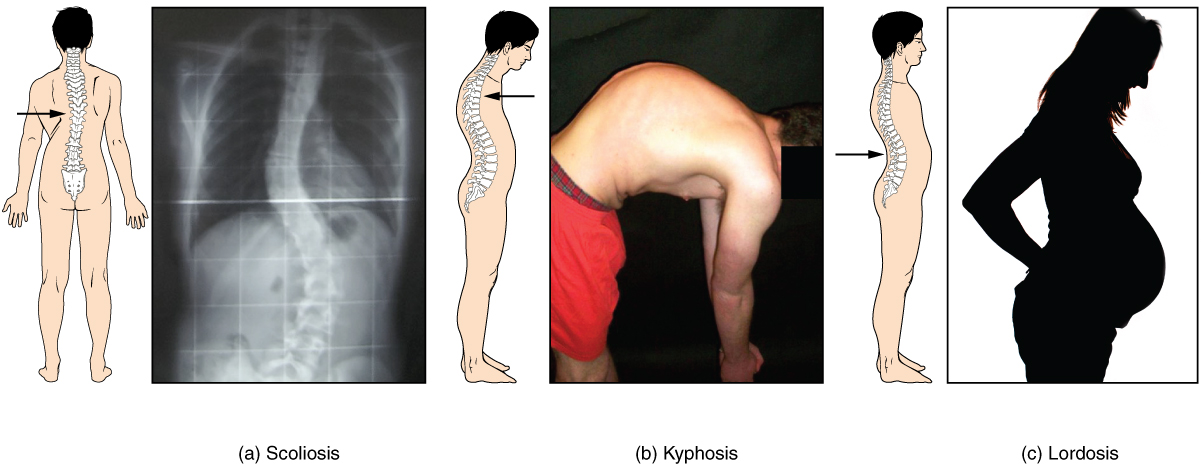
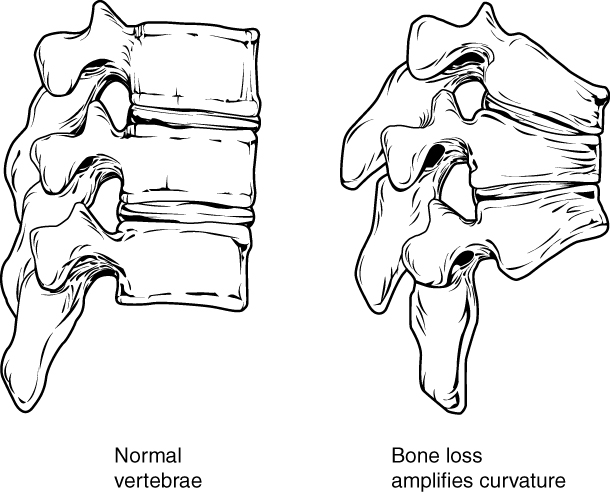
Fractures
A fracture is a broken bone. It will heal whether or not a physician resets it in its anatomical position. If the bone is not reset correctly, the healing process will keep the bone in its deformed position. Crepitation or crepitus is the creaking or popping sound that is heard when fractured bones move against each other. Fractures are classified by their complexity, location, and other features (see Figure 6.12). Some fractures may be described using more than one term because they may have the features of more than one type (e.g., an open transverse fracture).
Types of fractures include:
- Closed or simple – bones are broken but do not protrude the skin
- Open or compound – bones are broken and pierce through the skin
- Transverse – bone is broken straight across
- Spiral – the bone has twisted apart
- Comminuted – bones are broken and crushed into pieces
- Greenstick – bones are partially broken; occurs mainly in children
- Oblique – bones are broken at an angle
- Coles – bones are broken at the wrist or distal radius
- Stress – a small crack in the bone
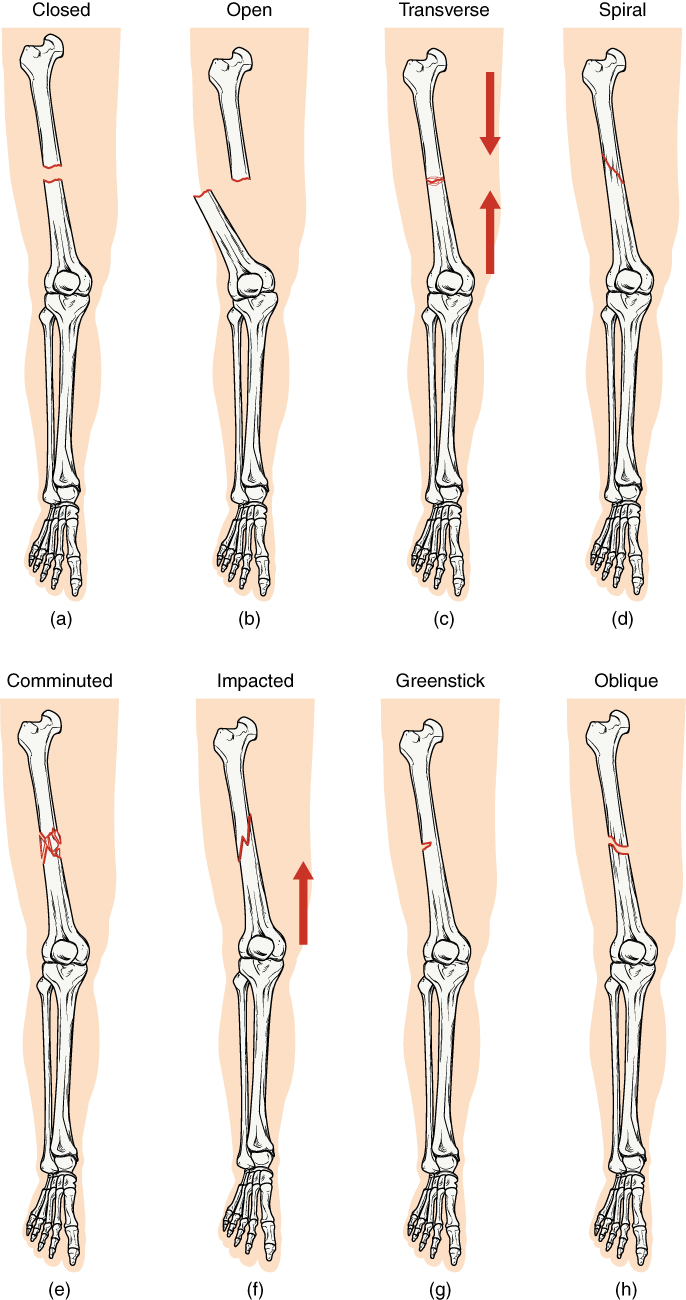
Bone Cancer
There are three types of primary bone cancers: osteosarcoma, Ewing Sarcomas, and chondrosarcoma. These are considered primary cancers because they originate in the bones. Osteosarcoma and Ewing Sarcomas primarily affect children, teenagers, and young adults. Chondrosarcoma primarily affects older adults (National Cancer Institute, n.d.-a). To learn more, visit the American Cancer Society’s web page on bone cancer.
Medical Specialties and Procedures Related to the Skeletal System
Orthopedic Surgeon
Orthopedic surgeons are medical doctors who have specialized training in the prevention, diagnosis, treatment, and surgery of disorders and diseases related to the musculoskeletal systems (Bureau of Labor Statistics, 2021a). For more details, please visit the American College of Surgeons’ page on Orthopedic Surgery.
Rheumatologist
Rheumatologists are medical doctors who specialize in the diagnosis and treatment of disorders of the joints, muscles, and bones. They diagnose and treat diseases such as arthritis, musculoskeletal disorders, osteoporosis, plus autoimmune diseases like ankylosing spondylitis, a chronic spinal inflammatory disease, and rheumatoid arthritis (Fowler et al., 2013). For more details, please follow the link to the American College of Rheumatology’s page on rheumatology.
Doctor of Chiropractic (DC)/Chiropractor
Chiropractors are required to have a Doctor of Chiropractic (D.C.) degree, which is a 4-year postgraduate professional degree, and a state license. Chiropractors focus on spinal adjustments, nutrition, and preventing injury without the use of pharmaceuticals or surgical procedures (Bureau of Labor Statistics, 2021b). To learn more, visit the Bureau of Labor Statistics’ website.
Physical Therapist
A physical therapist is a licensed professional who develops individualized treatment plans for their clients. These plans can include exercises, hands-on therapy, and equipment, such as canes or wheelchairs. Although current licensure laws require that those entering the field have a doctor of physical therapy degree, physical therapists who began working before those requirements went into effect may have a bachelor’s or master’s degree (Bureau of Labor Statistics, 2021c). To learn more, please visit the American Physical Therapy Association website.
Diagnostic Procedures
Common diagnostic procedures related specifically to the skeletal system include x-rays, bone mineral density testing, and arthroscopy.
- X-rays are common diagnostic tests used to confirm or rule out fractures and broken bones. The radiation dose is low so it is considered a safe diagnostic test (MedlinePlus, 2021).
- Dual x-ray absorptiometry (BMD), also called a bone mineral density test, is a test to determine osteoporosis by measuring the amount of bone mineral in a particular amount of bone (National Cancer Institute, n.d.-b).
- Arthroscopy is a procedure that involves a small incision and the insertion into the joint of an arthroscope, a pencil-thin instrument that allows for visualization of the joint interior. Small surgical instruments are also inserted via additional incisions. These tools allow a surgeon to remove or repair a torn meniscus or to reconstruct a ruptured cruciate ligament.
Practice Terms Related to the Skeletal System
Skeletal System Vocabulary
Abduction
Moving the limb or hand laterally away from the body, or spreading the fingers or toes.
Adduction
Movement that brings the limb or hand toward or across the midline of the body, or brings the fingers or toes together.
Amphiarthrosis
A slightly mobile joint.
Ankylosis
Fixation and immobility of a joint.
Appendicular skeleton
All bones of the upper and lower limbs, plus the girdle bones that attach each limb to the axial skeleton.
Arthralgia
Joint pain.
Arthritis
Chronic inflammation of the synovial joints.
Arthrocentesis
Surgical puncture to aspirate fluid from a joint.
Arthrodesis
Surgical fixation of a joint.
Arthrography
Process of recording a joint.
Arthroplasty
Joint replacement surgery.
Arthroscopy
Process of viewing a joint using an endoscope.
Articulations
Where two bone surfaces meet.
Autoimmune diseases/disorders
Disorders in which the immune system overreacts and begins to attack itself.
Axial skeleton
The central, vertical axis of the body, including the skull, vertebral column, and thoracic cage.
Bradykinesia
Condition of slow movement.
Bursitis
Inflammation of a bursa near a joint.
Chondromalacia
Degeneration of cartilage.
Chronic
A condition that lasts a long time with periods of remission and exacerbation.
Craniotomy
An operation in which a piece of the skull is removed.
Diarthrosis
Freely mobile joints.
Diskectomy
Excision of the intervertebral disk.
Discitis
Inflammation of the intervertebral disk.
Dyskinesia
Abnormal involuntary movements of the extremities, trunk, or jaw.
Edema
Swelling due to excessive liquid in the tissues.
Eversion
Foot movement in which the bottom of the foot is turned laterally, away from the midline.
Extension
Movement in the sagittal plane that increases the angle of a joint (straightens the joint).
Flexion
Movement in the sagittal plane that decreases the angle of a joint (bends the joint).
Hematopoiesis
The production of blood cells.
Hyperkinesia
Excessive movement of muscles of the body as a whole.
Hypertrophy
The enlargement of muscles.
Inversion
Foot movement in which the bottom of the foot is turned toward the midline.
Kyphosis
An excessive posterior curvature of the thoracic region; also called humpback.
Lordosis
Excessive anterior curvature of the lumbar vertebral column region; also called swayback.
Lumbar
Pertaining to the lumbar region of the spine (L1 to L5).
Lumbosacral
Pertaining to the region of the back that includes the lumbar vertebrae, sacrum, and nearby structures.
Muscular dystrophy
A general term for the group of inherited myopathies that are characterized by wasting and weakness of the skeletal muscle.
Osteitis
Inflammation of bone.
Osteoarthritis
The most common type of arthritis; associated with aging and “wear and tear” of the articular cartilage.
Osteoblast
The cell responsible for forming new bone.
Osteochondritis
Inflammation of bone and cartilage.
Osteocyte
Bone cell.
Osteomalacia
A softening of adult bones due to Vitamin D deficiency.
Osteomyelitis
Inflammation of bone and bone marrow.
Osteonecrosis
Abnormal condition of bone death (lack of blood supply).
Osteopenia
Abnormally low bone mass or bone mineral density.
Osteopetrosis
Abnormal condition of porous bones.
Osteoporosis
A disease characterized by a decrease in bone mass that occurs when the rate of bone resorption exceeds the rate of bone formation.
Osteosarcoma
Malignant tumor of bone.
Pelvic
Pertaining to the pelvis.
Pronation
Forearm motion that moves the palm of the hand from the palm forward to the palm backward position.
Rotation
Movement of a bone around a central axis or around its long axis.
Sarcopenia
Age-related muscle atrophy.
Scoliosis
Lateral curvature of the spine.
Spondyloarthritis
Inflammation of the joints of the spine.
Spondylosis
A degenerative spinal disease that can involve any part of the vertebra, intervertebral disk, and surrounding soft tissue.
Supination
Forearm motion that moves the palm of the hand from the palm backward to the palm forward position.
Synarthrosis
An immobile or nearly immobile joint.
Synovectomy
Excision of the synovial membrane.
Synovial sarcoma
Malignant tumor of the synovial membrane.
Tendinitis
Inflammation of the tendon.
Tenosynovitis
Inflammation of the synovial membrane of a tendon.
Vertebroplasty
A procedure used to repair a bone in the spine that has a break caused by cancer, osteoporosis, or trauma.
Test Yourself
References
Bureau of Labor Statistics. (2021a). Physicians and surgeons. In Occupational outlook handbook. U.S. Department of Labor. https://www.bls.gov/ooh/healthcare/physicians-and-surgeons.htm
Bureau of Labor Statistics. (2021b). Chiropractors. In Occupational outlook handbook. U.S. Department of Labor. https://www.bls.gov/ooh/healthcare/chiropractors.htm
Bureau of Labor Statistics. (2021c). Physical therapists. In Occupational outlook handbook. U.S. Department of Labor. https://www.bls.gov/ooh/healthcare/physical-therapists.htm
Centers for Disease Control and Prevention. (n.d.-a). Osteoarthritis. https://www.cdc.gov/arthritis/basics/osteoarthritis.htm
Centers for Disease Control and Prevention. (n.d.-b). Rheumatoid arthritis. CDC Arthritis Program. https://www.cdc.gov/arthritis/basics/rheumatoid-arthritis.html
Centers for Disease Control and Prevention. (n.d.-c). Gout. https://www.cdc.gov/arthritis/basics/gout.html
Fowler, S., Roush, R., & Wise, J. (2013). Concepts of biology. OpenStax. Access for free at https://openstax.org/books/concepts-biology/pages/1-introduction
MedlinePlus. (2021). X-rays. U.S. National Library of Medicine. https://medlineplus.gov/xrays.html
Momodu, I. I., & Savaliya, V. (2021). Osteomyelitis. In StatPearls [Internet]. https://www.ncbi.nlm.nih.gov/books/NBK532250/
National Cancer Institute. (n.d.-a). Primary bone cancer [Fact sheet]. National Institutes of Health, U.S. Department of Health and Human Services. https://www.cancer.gov/types/bone/bone-fact-sheet
National Cancer Institute. (n.d.-b). Dual x-ray absorptiometry. National Institutes of Health, U.S. Department of Health and Human Services. https://www.cancer.gov/publications/dictionaries/cancer-terms/def/dual-x-ray-absorptiometry
National Institute of Arthritis and Musculoskeletal and Skin Diseases. (n.d.-a). Arthritis. National Institutes of Health, U.S. Department of Health and Human Services. https://www.niams.nih.gov/health-topics/arthritis
National Institute of Arthritis and Musculoskeletal and Skin Diseases. (n.d.-b). Osteoporosis overview. National Institutes of Health, U.S. Department of Health and Human Services. https://www.bones.nih.gov/health-info/bone/osteoporosis/overview
National Institutes of Arthritis and Musculoskeletal and Skin Diseases. (n.d-c). Health topics: Fibromyalgia [PDF]. National Institutes of Health, U.S. Department of Health and Human Services. https://www.niams.nih.gov/print/view/pdf/advanced_reading_pdf_/advanced?view_args%5B0%5D=1957
Office of Communications and Public Liaison. (2020). Myasthenia gravis fact sheet. National Institute of Neurological Disorders and Stroke, U.S. Department of Health and Human Services. https://www.ninds.nih.gov/Disorders/Patient-Caregiver-Education/Fact-Sheets/Myasthenia-Gravis-Fact-Sheet
Image Descriptions
Figure 6.1 image description: This diagram shows the human skeleton and identifies the major bones. The left panel shows the anterior view (from the front) and the right panel shows the posterior view (from the back). Labels read (from the top of the skull): skull (cranial portion, facial portion), pectoral shoulder girdle, clavicle, scapula, thoracic cage (sternum, ribs), upper limb (humerus, ulna, radius, carpals, metacarpals, phalanges), vertebral column, pelvic girdle (hip bones), lower limb (femur, patella, tibia, fibula, tarsals, metatarsals, phalanges). [Return to Figure 6.1].
Figure 6.2 image description: This image shows the structure of the vertebral column. The left panel shows the front view of the vertebral column. Labels and the right panel show the side view of the vertebral column. labels read (from top): 7 cervical vertebrae (C1-C7) form cervical curve, 12 thoracic vertebrae (T1-T12) form the thoracic curve, intervertebral disc, 5 lumbar vertebrae (L1-L5) form lumbar curve, Fused vertebrae of sacrum and coccyx form a sacrococcygeal curve, sacrum, coccyx. [Return to Figure 6.2].
Figure 6.3 image description: This figure shows the skeletal structure of the rib cage. The left panel shows the anterior view of the sternum. Labels read (from top): clavicular notch, jugular notch, manubrium, sternal angle, body, xiphoid process. The right panel shows the anterior panel of the sternum including the entire rib cage. Labels read (from top): jugular notch, clavicular notch, clavicle, sternum (manubrium, body, xiphoid process), scapula, sternal angle, costal cartilages, intercostal space. Ribs are numbered 1-12 from the top. [Return to Figure 6.3].
Figure 6.4 image description: This diagram labels the bones of the lower arm (excluding the hands). Labels read (from top): olecranon process, head of radius, radial notch of the ulna, trochlear notch, coronoid process, radial tuberosity, proximal radioulnar joint, neck of radius, radius, interosseous membrane, ulna, ulnar notch of the radius, head of the ulna, distal radioulnar joint, styloid process of ulna, styloid process of radius. [Return to Figure 6.4].
Figure 6.5 image description: This diagram shows an anterior and posterior view of the hands with corresponding labels. Anterior view labels read (from top): middle finger, ring finger, index finger, little finger, thumb, phalanges (distal, proximal), metacarpals, carpals, ulna, radius. Posterior view labels read (from top): Phalanges (distal, middle, proximal), head shaft and base of the proximal phalanx, head shaft and base of the metatarsal, metatarsals 1-5, carpals, ulna, radius. [Return to Figure 6.5].
Figure 6.6 image description: This image shows the structure of the tibia and the fibula. The left panel shows the anterior view. Labels read (from top): lateral condyle, medial condyle, tibial tuberosity, anterior border, interosseous membrane, fibula, tibia, medial malleolus, lateral malleolus, articular surface. The right panel shows the posterior view. Labels read (from top): the articular surface of medial and lateral condyles, medial condyle, head of the fibula, soleal line, interosseous membrane, tibia, fibula, medial malleolus, lateral malleolus, articular surface. [Return to Figure 6.6].
Figure 6.7 image description: This figure shows the bones of the foot. The left panel shows the superior view. Labels read (from toes): distal, proximal phalanges, distal phalange, middle phalange, proximal phalanx, medial cuneiform, intermediate and lateral cuneiforms, navicular, cuboid, talus, trochlea of talus, calcaneus. The top right panel shows the medial view. Labels read (from left to right starting at toe): first metatarsal, medial cuneiform, intermediate cuneiform, navicular, talus, calcaneus, facet for medial malleolus, sustentaculum tali (talar shelf), calcaneal tuberosity. The bottom right panel shows the lateral view. Labels read (from left at the heel, to right): calcaneus, talus, facet for lateral malleolus, cuboid, navicular, intermediate and lateral cuneiforms, fifth metatarsal. [Return to Figure 6.7].
Figure 6.8 image description: This multi-part image shows different types of movements that are possible by different joints in the body. Labels read (from the top, left): a and b angular movements: flexion and extension at the shoulders and knees, c) angular movements: flexion and extension of the neck (arrows pointing left and right to indicate movement). Labels (from the bottom, left) read d) angular movements: flexion and extension of the vertical column, e) angular movements abduction, adduction, and circumduction of the upper limb at the shoulder, f) rotation of the head, neck, and lower limb. [Return to Figure 6.8].
Figure 6.9 image description: This multi-part image shows different types of movements that are possible by different joints in the body. The top left image shows a hand and forearm in the pronation and supination positions. The top middle image shows a foot in the dorsiflexion and plantar flexion positions. The top right image shows a foot in the inversion and eversion positions. The bottom left image shows the retraction and protraction of a man’s mandible. The bottom middle image shows the elevation and depression of a man’s mandible. The bottom right image shows a hand in the opposition position. [Return to Figure 6.9].
Figure 6.10 image description: This image shows the changes to the abnormal curves of the vertebral columns in different diseases. The left panel shows the change in the curve of the vertebral column in scoliosis, the middle panel shows the change in the curve of the vertebral column in kyphosis, and the right panel shows the change in the curve of the vertebral column in lordosis. [Return to Figure 6.10].
Figure 6.11 image description: This figure shows the changes to the spine in osteoporosis. The left panel shows the structure of normal vertebrae and the right panel shows the curved vertebrae in osteoporosis. [Return to Figure 6.11].
Figure 6.12 image description: In this illustration, each type of fracture is shown on the right femur from an anterior view. In the closed fracture, the femur is broken in the middle of the shaft with the upper and lower halves of the bone completely separated. However, the two halves of the bones are still aligned in that the broken edges are still facing each other. In an open fracture, the femur is broken in the middle of the shaft with the upper and lower halves of the bone completely separated. Unlike the closed fracture, in the open fracture, the two bone halves are misaligned. The lower half is turned laterally and it has protruded through the skin of the thigh. The broken ends no longer line up with each other. In a transverse fracture, the bone has a crack entirely through its width, however, the broken ends are not separated. The crack is perpendicular to the long axis of the bone. Arrows indicate that this is usually caused by compression of the bone in a superior-inferior direction. A spiral fracture travels diagonally through the diameter of the bone. In a comminuted fracture, the bone has several connecting cracks at its middle. The bone could splinter into several small pieces at the site of the comminuted fracture. In an impacted fracture, the crack zig zags throughout the width of the bone like a lightning bolt. An arrow indicates that these are usually caused by an impact that pushes the femur up into the body. A greenstick fracture is a small crack that does not extend through the entire width of the bone. The oblique fracture shown here is traveling diagonally through the shaft of the femur at about a thirty degree angle. [Return to Figure 6.12].
The production of blood cells (Betts et al., 2013)
Where two bone surfaces meet (Betts et al., 2013)
Moving the limb or hand laterally away from the body, or spreading the fingers or toes (Betts et al., 2013)
Movement that brings the limb or hand toward or across the midline of the body, or brings the fingers or toes together (Betts et al., 2013)
A disease characterized by a decrease in bone mass that occurs when the rate of bone resorption exceeds the rate of bone formation (Betts et al., 2013)
Chronic inflammation of the synovial joints (Betts et al., 2013)
Swelling due to excessive liquid in the tissues (Betts et al., 2013)
Joint pain (National Cancer Institute, n.d.)
Fixation and immobility of a joint (National Library of Medicine, 2021)
The most common type of arthritis; associated with aging and “wear and tear” of the articular cartilage (Betts et al., 2013)
A transient exacerbation of symptoms of an existing disease or condition (National Library of Medicine, 2021)
A decrease in or disappearance of signs and symptoms (Betts et al., 2013)
A disease in which antibodies made by a person’s immune system prevent certain nerve-muscle interactions, causing weakness in the arms and legs, vision problems, and drooping eyelids or head (National Cancer Institute, n.d.)
A condition that lasts a long time with periods of remission and exacerbation (Betts et al., 2013)

